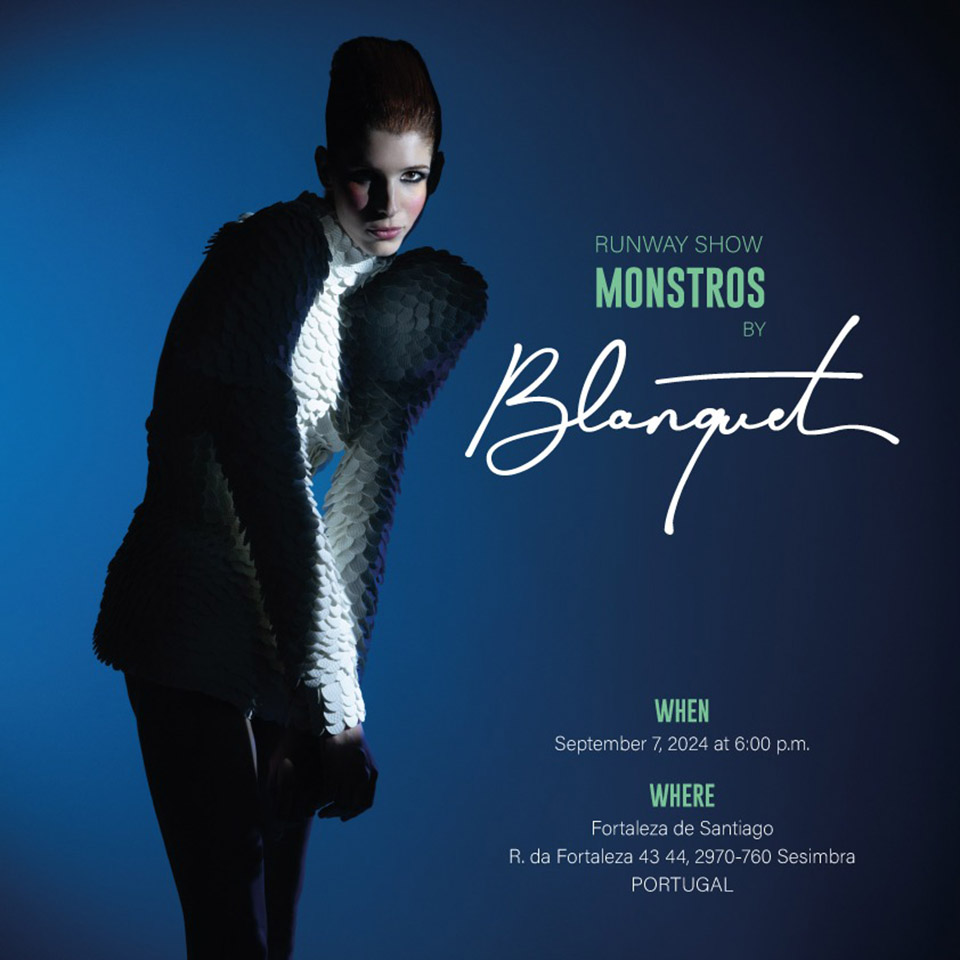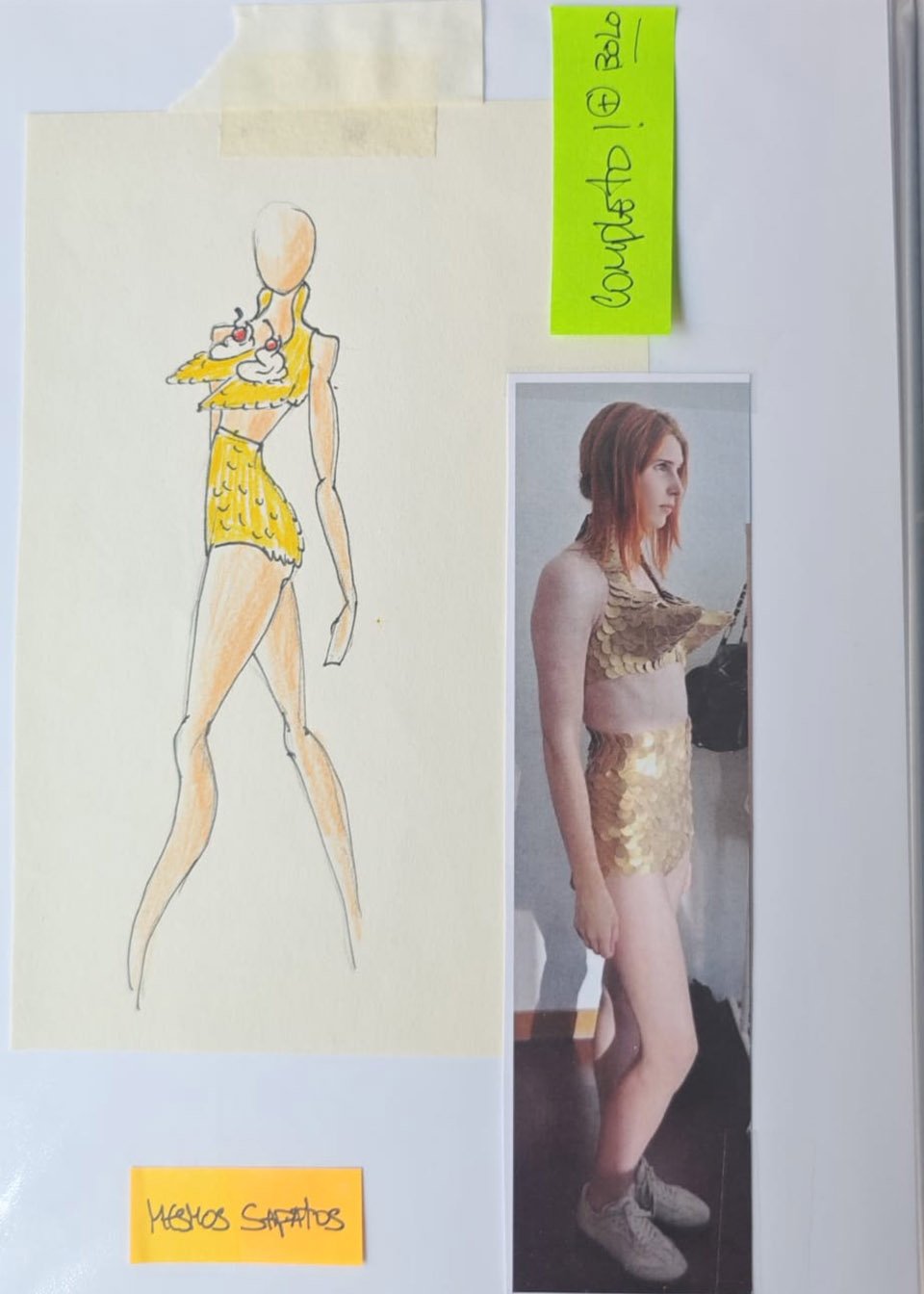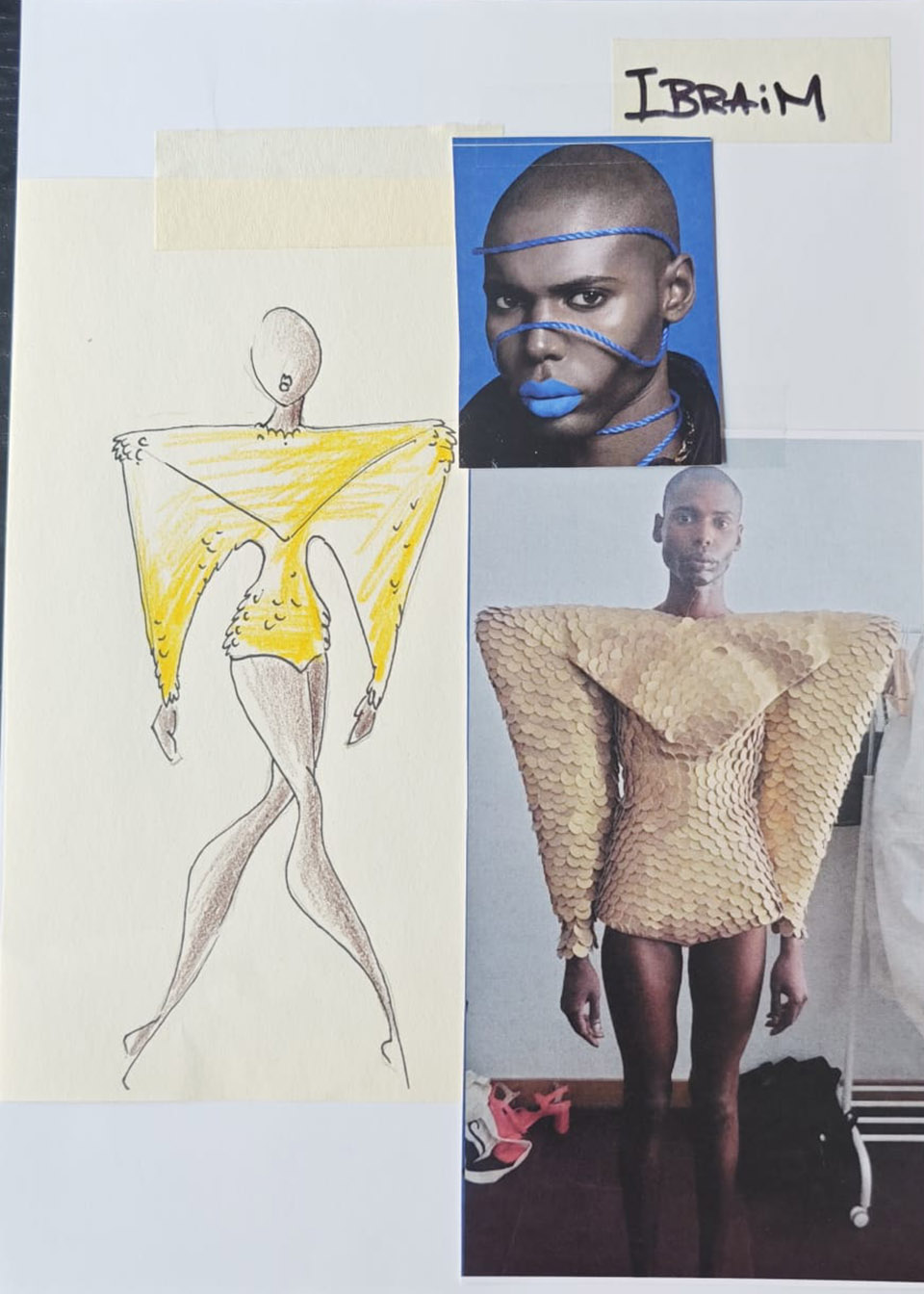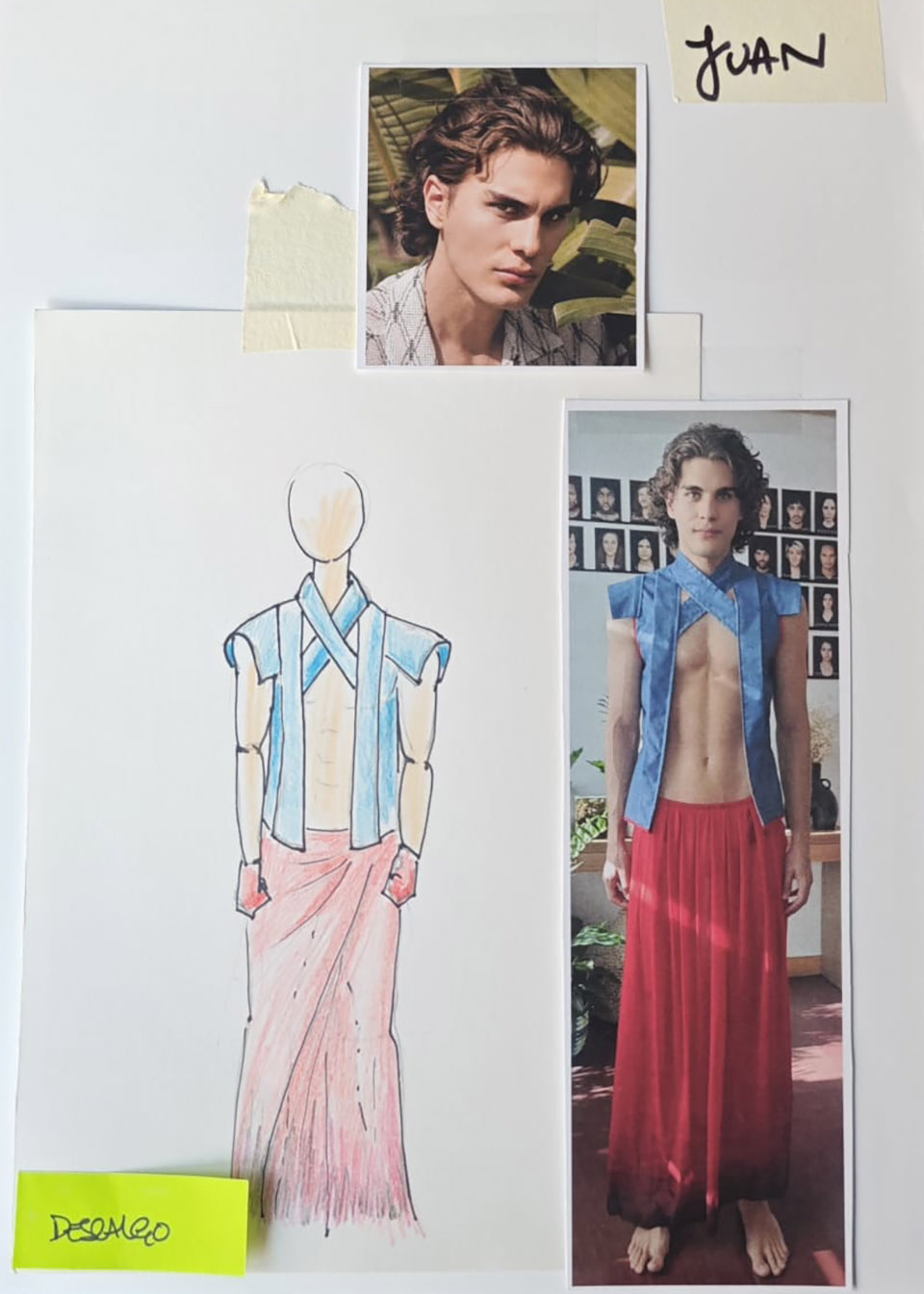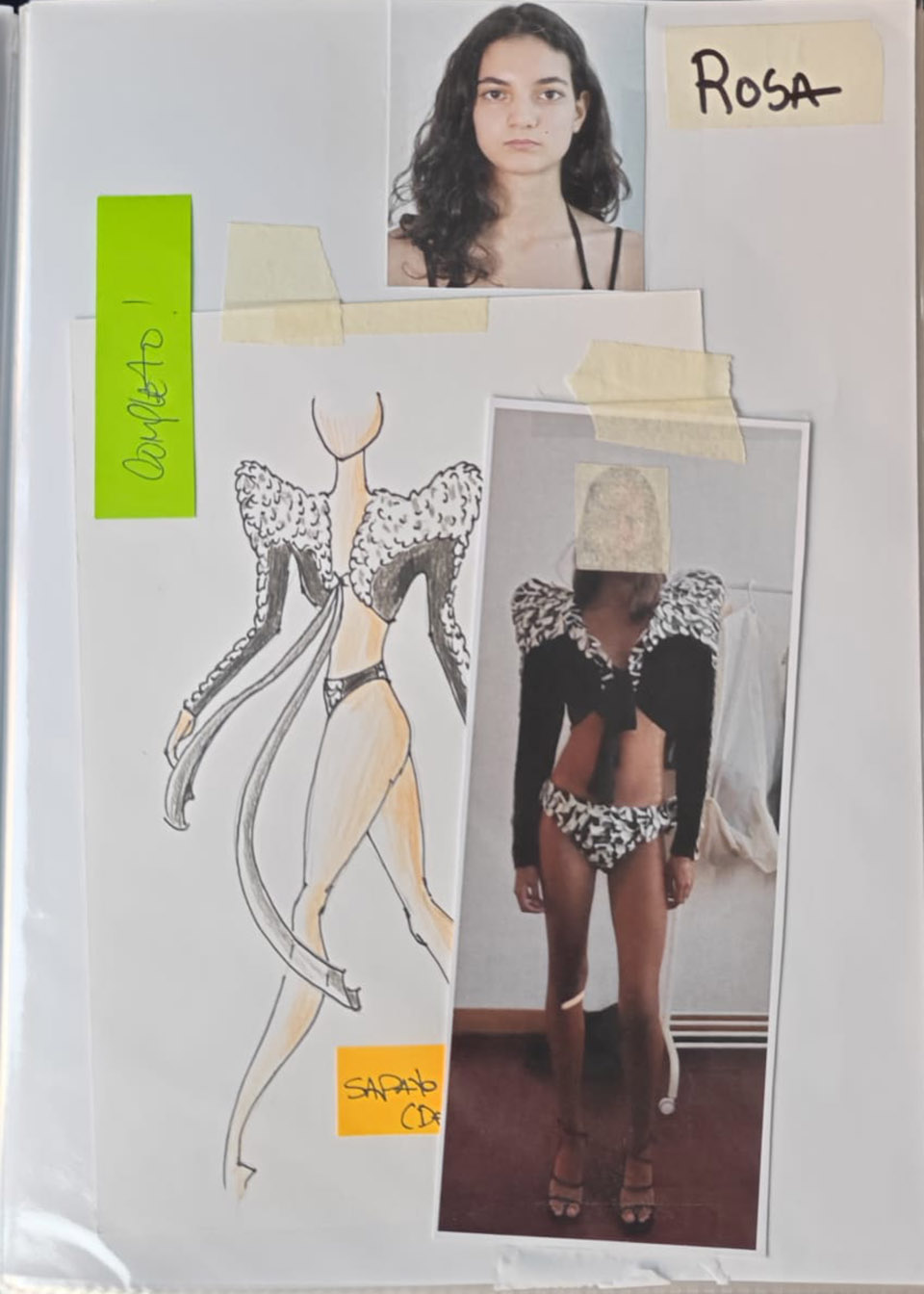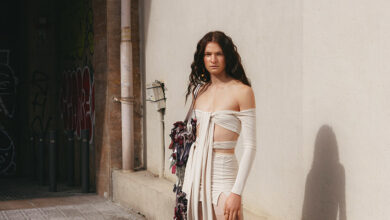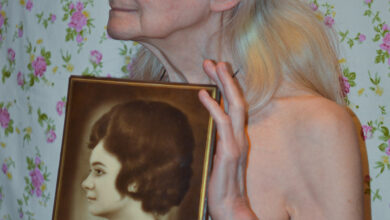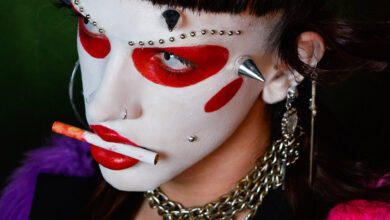
Filipe Blanquet, Portuguese multidisciplinary designer, pâtissier and artist, spans several artistic fields to create unique sculptural work. In our interview, Filipe delves into the inspirations behind his latest collection «Monsters», sharing the creative process and technical innovations that define his work, from the fusion of textures to his focus on sustainability.
Photography Pedro Castelhado
Assisted by Tomás Nazaré
Featuring fashion pieces by Filipe Blanquet
Makeup Antónia Rosa with Clarins
Hair Paulo Vieira with Joico Portugal
Model Ariel de Abreu e Cunha from Papaya Management
Interview and words Maxime Pereira
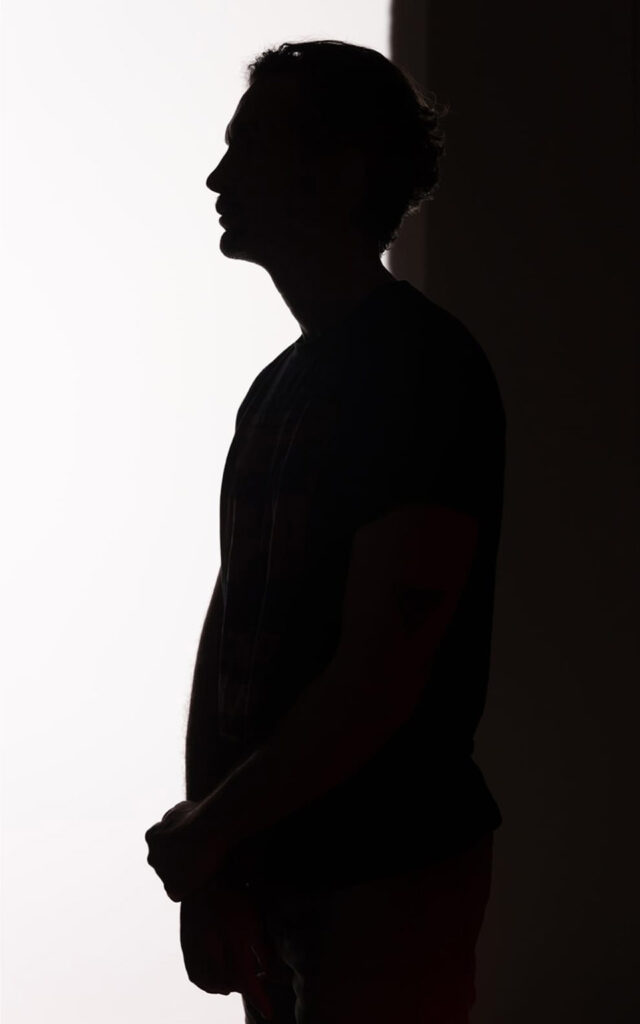
Originally trained in architecture and design, Filipe then ventured into the world of pastries and ice cream before turning to fashion, where he now combines these different disciplines to create unique pieces. With ZOOT, Filipe shares his fascinating journey, from his beginnings as a graphic designer to the creation of sculptural garments. He gives an insight into his creative process, his technical innovations and the inspirations behind his latest collection.
It is his first big show after nine years and it consists of 40 looks. Filipe called it «Monsters» and explains to ZOOT:
My monsters are beautiful creatures – very charming but inside also very dark. I want to show that beauty can also have a dark, monstrous side.
The complete show cast involves non-binary and divers models from new Portuguese modelling agency Papaya Management. Filipe worked directly with the models to develop and mould the looks on their body. It was a challenge in many ways and the lean long body types of several non-binary models, inspired Filipe to play with different volumes and proportions to enhance body pieces in a surreal way, sometimes absurd, non-human.
Our team had the chance to be part of his campaign and shoot three preview looks on model Ariel Del Arco, who was Filipe´s muse for this collection. All three were made of a silicon based material with a crocodile-like print. Filipe was cutting out single scales – to create an all-over-skin-fish-or reptile-like effect. The powerful message: A second skin, that also can be discarded or replaced, suggesting change is possible, we all can!
The show will be set in a very special venue in his hometown, the Fortaleza de Santiago in Sesimbra. It was built between 1642 and 1648 on the site of an earlier 16th-century Manueline fort.
ZOOT: Can you tell us about your transition from architecture to pastry, and then to fashion? What triggered this career change?
Filipe Blanquet: My original degree was in architecture and design, which would have allowed me to pursue a career as an industrial or graphic designer. Thus, I began working as a graphic designer. Being artistic, I had certain hopes for this job that were not realized in the end. I was dissatisfied and made the decision to pursue culinary training because I was only able to fry eggs. I became in love with pastry throughout this course, and I understood that I could express myself artistically in addition to using flavour combinations. Through intensely refining my imagination, I was able to expand it during my training over pastry. The idea that pastry may become fashionable struck me when I tried to create a sugar sculpture that moved, much like a robot. After trying a few other approaches without success, to simplify things, I just opted to design something wearable.
ZOOT: Your work is like a fusion between fashion and pastry. How would you describe this intersection, and what attracts you to this fusion of mediums?
Filipe Blanquet: Combining these two, in my opinion, will enhance fashion even more by incorporating the sensorial component of taste. It is really challenging for me to keep looking for methods to deepen this combination, especially when experimenting with the various textures that pastries have to offer.

ZOOT: How does the public generally react to your creations ? Are there any reactions or feedback that have particularly stood out to you?
Filipe Blanquet: Seeing the different reactions that individuals have to my artwork—especially with relation to sugar pieces—is intriguing. This is because most people’s ideas about what “sugar clothing” really entails are not in line with reality. Most people are pleasantly surprised and satisfied.
ZOOT: Do you consider yourself primarily a pastry chef, artist, fashion designer, or architect?
Filipe Blanquet: Answering this question is difficult. Since it is a part of who I am, I perceive myself as all of them, and it is this combination that inspires my creativity. “Designer” would be a more accurate term.

ZOOT: What advice would you give to someone who wants to combine different artistic disciplines in their work, as you have done?
Filipe Blanquet: Permit the person doing it, to try, to be creative and ambitious. Even if you have multiple unsuccessful attempts, you will still learn from them and get the abilities and resources you need to be successful.
ZOOT: Can you walk us through a typical day in your studio ? What does your creative process look like from start to finish working with sugar?
Filipe Blanquet: Even in the unlikely event that nothing works out, I detest starting anything without a concept or a gripping story. I will occasionally sketch the object first. Since my hands are the only ones that can give the [sugar] object shape, I don’t give it any thought. I have to continually be considerate of the pieces’ drying time. That’s why it’s never an easy process. It goes without saying that the complexity of the piece will affect how long it takes to assemble the [sugar] pieces—it may take several weeks at times.

ZOOT: What are the main inspirations behind this new collection in terms of shapes, cuts, colors, and perhaps storytelling ?
Filipe Blanquet: Speaking about this new collection gets me thrilled every time since I think it’s a highly enriched project. Not only is it made of a variety of materials (fabrics, feathers, and sugar, among others), but it also has a surreal quality. The “Monsters” collection features a variety of bizarre and fantastical creature, but above all, they are incredibly endearing. Though the silhouettes are somewhat overdone, they oddly accentuate the model wearing them. I make it a point to create silhouettes that not only complement non-binary models but also bring out the best in them, and I don’t disguise the fact that I love working with them.
Zoot: In this collection, you seem to focus more on textiles, whereas in your previous collections, your primary material was sugar. What is this new medium you are exploring?
Filipe Blanquet: At times, it appears that my career path differs slightly from most designers. I started with fully conceptual pieces, and now I strive to blend the conceptual with more commercial piece. Working with fabric is new to me. Still, I find it enjoyable. I’ll explore it in the same way that I have with other materials I’ve worked with, hoping to push my imagination to new heights.
Zoot: Was this return to textiles a necessary step in your creative and professional journey?
Filipe Blanquet: Yes, without a doubt. Finding a balance between wearable and completely conceptual fashion is tough and complex.

Zoot: Has this new material inspired you to create new forms around the body? How does it influence your design process?
Filipe Blanquet: Every material exhibits a distinct “behaviour”. It’s not always possible to combine different materials. We must explore it and make use of its finest qualities. I’m currently attempting to accomplish that, collaborating with professional seamstresses. This collaboration enhances the capability and the ability to bring shape to new innovative pieces, combining unique materials into one.
Zoot: Your creations are often very sculptural. What are the main challenges you face when designing these volumes around the human body, especially with this new textile?
Filipe Blanquet: It’s always a struggle to create volumes in a beautiful manner. Testing in mannequins frequently is what I find to be helpful.
Zoot: You use some modules similar to those in your previous collections, but with this new material. Are these recurring modules inspired by something natural or animalistic?
Filipe Blanquet: As a conceptual fashion designer, I am drawn to the surreal universe. In my new collection, I made the decision to delve deeper into a more animalistic motif. I thereby expanded the possibilities in terms of creating new silhouettes.
Zoot: Do you think this new medium allows you to get closer to the body, creating a sort of second skin, almost like scales?
Filipe Blanquet: It’s intriguing to bring up the subject of a second skin because that’s the idea I choose to focus on with this collection.
That is exactly what the invention of the scale effect suggests: a second skin that can be discarded or even replaced.

ZOOT: What technical innovations have you introduced in this collection compared to your previous work?
Filipe Blanquet: In my earlier works, fabric served as my substrate whenever I made a piece using sugar. This indicated that the form was not adhered to the model’s body entirely (like having a second skin). For this collection, using the same ideal, I used a silicone-based material as my substrate using sugar pieces to shape it. Without a doubt, this technique was a novelty in my work.
ZOOT: How does the drawing process play a role in the design of your pieces ? Is it a key step for you?
Filipe Blanquet: Ideally, even if I sketch it first, it’s just a concept. The real form takes place in real time, after shaping it and make it function as I imagined, most of the times, unrelated to the original drawing.
ZOOT: Do textures play a crucial role in this collection ? Are you using different techniques to create tactile and visual contrasts ?
Filipe Blanquet: Textures are just as important to me as colour selection. To provide depth and richness to the sugar-free clothing, textiles with coarse textures were selected and meticulously cut into scale shapes by hand, also considering its reflective nature.

ZOOT: What is the significance of the colors chosen for this collection, which includes three silhouettes in black, black and white, and beige?
Filipe Blanquet: This collection’s colour palette spans from blood red to pearl tones connected to life and purity, white to black to tempt adaptability, and finally gold, firmly associated with the divine. Additionally, to flourish my colour palette, I decided to use green, pink, and blue, to honour nature.
ZOOT: When you create, do you consider the sustainability and ecological impact of your work?
Filipe Blanquet: I believe it is absurd to not consider sustainability when designing as of right now.
I genuinely make a effort to recycle and refurbish materials. Feathers are one example I can give. Although feathers were intended to be thrown away, I used them as a material for my collection. As with many materials, after being cleansed and dried, they are given a new significance in their life cycle.
ZOOT: What do you hope people take away from this new collection and your artistic approach?
Filipe Blanquet: Even the most virtuous animal can turn into a terrifying creature. The duality of nature and life itself. The power of illusion: gods or monsters?
ZOOT: How important is storytelling in your collections? Do you create narratives around your designs, and does the photoshoot contribute to this process?
Filipe Blanquet: Without a doubt, in my opinion, creating without a narrative is absurd. Effective storytelling is essential for communicating ideas. Not only do I mean the runway shows, but also all of the promotional activities like photoshoots and multimedia.
ZOOT: Were there any particular challenges you encountered while creating this collection? How did you overcome them?
Filipe Blanquet: Working with novel materials can occasionally result in both positive and negative outcomes. I had such experience while working with different sources of silicone-based materials. Some are more bendable than others, and some don’t combine well with different materials such as feathers and sugar. While experimenting, you need to try different combination processes until you reach the ideal combination.
ZOOT: Which elements of your architectural training are most present in this new collection?
Filipe Blanquet: The knowledge I’ve gained from my architectural background such as creativity, attention to detail, the ability to think outside the box, and design skills were very helpful and necessary, to create the structures for the most oddly shapes and volumes in my collection. This background always complements my ideologies to innovate and combine materials.

Thank you Filipe!
[divider style=”solid” top=”20″ bottom=”20″]
Edited by Andrea Probosch
To boot…
Check out two editorial collaborations with Filipe Blanquet on ZOOT, both featuring sugar art pieces:
A Taste of Metropolis and Bandits at heart
Filipe Blanquet, conceptional fashion designer & pastry chef
@filipeblanquet I @__blanquet__I @bizarrogelato
